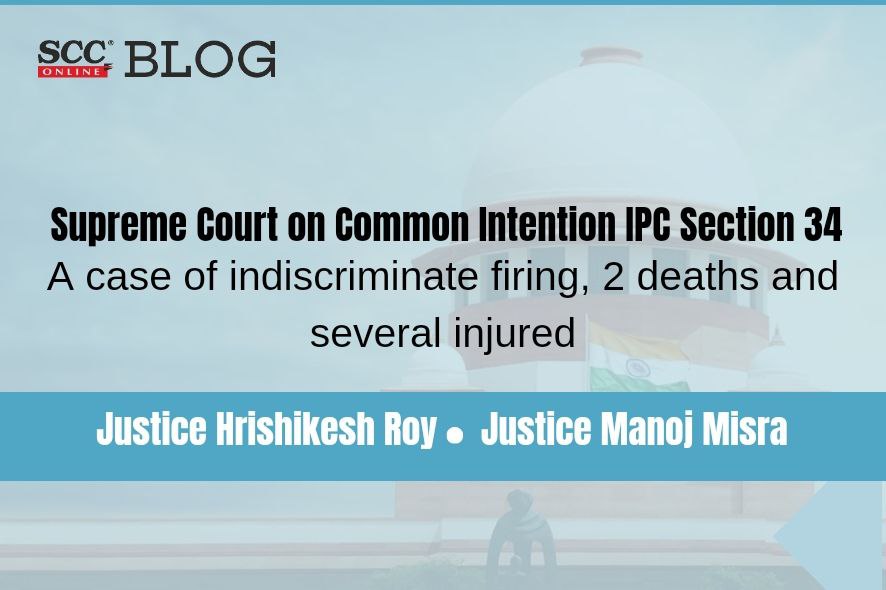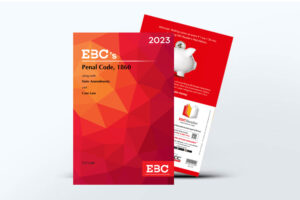Supreme Court: Appeals challenging judgment and order passed by Delhi High Court affirming Trial Court’s order of conviction and sentence of the appellants under Sections 302, 307 and 34 of the Penal Code, 1860 (‘IPC’) against 4 of the appellants, the Division Bench of Hrishikesh Roy and Manoj Misra*, JJ. Partly allowed the appeal, being convinced that the appellants may not be regarded to have common intention for offence under Section 302, but upheld conviction under Section 307 read with Section 34.
Factual Matrix
The instant matter pertains to indiscriminate firing from a licensed single-barrel gun by one of the appellants which resulted in two deaths and pellet injuries to 26 others, some being grievous in nature. The appellants and one acquitted by the High Court were roped in through Section 34 of IPC for exhorting the assailant to fire gunshots. As per the prosecution, the incident took place due to an altercation between two families after boys on the appellant’s side teased a girl.
The assailant took a plea of self-defense that a mob had surrounded his house and threatened to torch it, which was found unacceptable and discarded after careful examination by the Trial Court and the High Court. The witnesses had stated for their presence at the time of altercation and at the roof top exhorting the assailant to fire.
Court’s Analysis
Considering the lower Court’s disbelief on self-defense plea that fires were shot to disburse the crowd surrounding the house, the Court went on to check the role of the appellants. The Court took note of the fact that the two deceased were not related to the opposite group, which led the prosecution to use the words supporters to show that all the accused had a common intention to cause bodily harm to persons who suffered injuries, since they left the place of altercation together, appeared at the roof-top together when gunshots were fired. The Court further perused the testimonies regarding the role of appellants.
The Court stated that in the absence of cogent evidence of the assailant being instigated/exhorted assumed importance from the testimony of witnesses, since neither of the deceased persons were a supporter of the rival faction. The fact led the Court to consider whether the appellants could be named to have shared common intention with the assailant to warrant their conviction under Section 307 r/w 34 of IPC.
Law for conviction based on Common Intention — IPC Section 34
The Court referred to Pandurang v. State of Hyderabad, 1954 SCC OnLine SC 39 and Balu v. State (UT of Pondicherry), (2016) 15 SCC 471 to indicate that to fasten the liability with the aid of Section 34 of IPC, it is necessary to prove the common intention to commit the crime actually committed, and that each accused of such crime can be convicted only if it is in furtherance of common intention of all. It further explained that “The question whether there was any common intention or not depends upon the inference to be drawn from the proven facts and circumstances of each case. The totality of the circumstances must be taken into consideration in arriving at the conclusion whether the accused had a common intention to commit an offence with which they could be convicted.”
In this context, the Court cited Mewa Ram v. State of Rajasthan, (2017) 11 SCC 272 wherein, the accused exhorted to kill one, but someone else was killed, which led the Court to deny conviction as per IPC Section 34.
Common Intention in the instant matter
The Court highlighted that the appellants had no animosity or grudge against the two deceased. It also pointed towards the inconsistency in statements of witnesses to establish beyond reasonable doubt regarding the appellants having exhorted the assailant to fire shots at the two deceased. The Court viewed that general exhortation was not sufficient to fasten vicarious liability for shots fired when the witnesses were not consistent regarding whether shots were fired before or after the exhortation made by the appellants. Considering the evidence, the Court commented that even if the assailant had not been instigated by any of the appellants, he might have fired from his weapon to stamp his authority thereby killing the two deceased being his individual act.
The Court was cautious that in the absence of clear and cogent evidence of shots being fired in furtherance of a common intention, it would be extremely unsafe to convict the appellants of offence of murder with the aid of Section 34 of IPC.
Escaping Liability for IPC Section 307 r/w 34
On the question of whether the appellants could escape liability for offence punishable under Section 307 with the aid of IPC Section 34, the Court observed that the appellants had knowledge that the act which the assailant was exhorted to commit was so imminently dangerous that it would cause death or such bodily injury as is likely to cause death of a person as per Section 300 of IPC. Thus, the Court said that the gunshots fired indiscriminately could be said to be a criminal act done by several persons in furtherance of the common intention of all. Therefore, the Court found the appellants liable to be convicted for offence under Section 307 r/w 34 of IPC.
Incriminating Circumstance of Exhortation
Considering whether not putting the incriminating circumstance of exhortation to the appellants while recording statements under Section 313 of CrPC affected their conviction under Section 34, the Court noted that the gist of the testimony of various witnesses delineating the exact role played by the appellants was not put to the appellants for the purposes of recording their statement.
The Court referred to Tara Singh v. State, 1951 SCC 903, Alister Anthony Pareira v. State of Maharashtra, (2012) 2 SCC 648, Nar Singh v. State of Haryana, (2015) 1 SCC 496, Shobhit Chamar v. State of Bihar, (1998) 3 SCC 455 to point towards the legal position that “to enable an accused to explain the circumstances appearing in the evidence against him, all the incriminating circumstances appearing against him in the evidence must be put to him. But where there has been a failure in putting those circumstances to the accused, the same would not ipso facto vitiate the trial unless it is shown that its non-compliance has prejudiced the accused.”
The Court viewed that although the incriminating evidence of exhorting the assailant was not put to the appellants, they were aware of the prosecution case against them even through the FIR delineating their role, and highlighted that no such plea was raised earlier, denying any prejudice. It further took the view that conviction of the appellants is not vitiated for alleged non-compliance of Section 313 CrPC.
Conclusion
The Court partly allowed the instant appeal, upheld appellants’ conviction under IPC Section 307 r/w 34 and affirmed the sentence awarded for such offences but set aside the conviction and sentence under Section 302 r/w 34 of IPC. The Court, therefore, cancelled the bail bonds of appellants reported to be on bail.
[Sunil v. State (NCT of Delhi), 2023 SCC OnLine SC 1203, decided on 21-09-2023]
Judgment authored by: Justice Manoj Misra
Know Thy Judge | Supreme Court of India: Justice Manoj Misra
Advocates who appeared in this case :
For Appellant: Advocate on Record Sudarshan Rajan, Advocate Mahesh Kumar, Advocate Ramesh Rawat, Advocate Rohit Bhardwaj, Advocate Hitain Bajaj, Advocate Ashutosh Gupta, Advocate Vijay Kumar Sharma, Advocate Nand Ram, Advocate Md Qamar Ali, Advocate Rajeev Khurana
For Respondents: Advocate on Record Shreekant Neelappa Terdal








